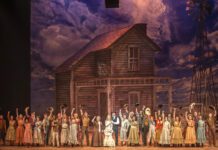
A cowboy working on the Drummond Ranch rounds up cattle to send to auction.
Photo by Nathan Harmon.
Itis perhaps the single, ubiquitous image of American culture, both in the subconscious of her people and in her global image. It has been glorified in literature and in film well before the latter had the benefits of color or sound. It’s the pejorative used by American critics but also the grudgingly admired singular image praised by people freed by U.S. soldiers’ blood in Europe. Twice.
“It” is the American cowboy, the drover, the romantic image of Americans’ conquering of the West and the lifestyle – real and romanticized – that sprung from it. From early figures like Gene Autry and Tex Ritter singing on the open range to Clint Eastwood and his award-winning work in the revisionist western, Unforgiven, cowboys and the work they do have been glamorized and heroes to countless children.
Today, though, the drover’s most archetypal responsibility – driving cattle from point A to point B, often across long distances and often through hostile territory – has been replaced by animal husbandry, by technology and by challenges more likely to relate to weather and government regulation than cattle rustlers and corrupt lawmen. Half a century ago, cowboys and the cattle ranching industry they support might well still have resembled those Hollywood-inspired images. Today’s cattle ranchers are as likely to be adept at composing feed mixtures, selective cattle breeding and utilizing computer models to plan adequate watering sites.
Ranching is, indeed, more industry than many would imagine; but less so than those who think it is entirely a high-tech, cookie-cutter automated process. Despite many changes, cattle ranching and the men and women who work in the industry still possess many of the same traits that have defined them since the challenge of the West: connection to the land and to the cattle, rugged individualism and a sense of heritage.
Where Have All The Cowboys Gone?
Quite a few cowboys remain in Oklahoma, if statistics are any evidence. According to the state Department of Agriculture, Food and Forestry 2011 agricultural output, which includes cattle ranching, accounted for billions of dollars in total economic impact.
“Ranching, of course, supports other industries,” says Oklahoma Commissioner of Agriculture Jim Reese. “In 2011, there was about a $36 billion total impact from agriculture related industries. That’s based on the increase in cost of grain and fuel but also includes the added value expenses of buying grain, spraying pastures, etc. The last three years, it was much higher than that.”
Reese says about $7 billion in agricultural products are sold each year, including almost $4 billion in cattle in 2011.
“We’re an economy that grows $7 billion in new wealth every year,” says Reese. “Agriculture – ranching – creates wealth because cows are born and grow up. That doesn’t include the service industry and others that are supported by ranching.”
Michael Kelsey, executive director of the Oklahoma Cattlemen’s Association, says ranching is one of the leading industries in the state “as a function of land mass and land use.
“Beef cattle is the largest sector within agriculture,” Kelsey continues. “Beef cattle is big business. What’s unique about Oklahoma is the tremendous heritage of ranching. There are so many ranchers that are fifth- and sixth-generation ranchers. Now that sixth generation might be in diapers right now, but they’ll be there. It’s a priority for a lot of ranching families to uphold that tradition.”
Still, the industry has changed dramatically.
“People who only see food at the supermarket might think ranching is the same as it’s always been, and it’s not,” Reese says. “It’s not even the same as it was five years ago. The way cattle are bred and raised is different. The industry is much more advanced that way, as well as in other ways.”
The market for beef cattle has also changed in recent years.
“It’s completely different than anything we’ve seen in the past,” Kelsey says. “It’s a new normal, or we don’t know what ‘normal’ is anymore. The cattle cycle ebbs and flows depending on the market. But the cattle cycle isn’t normal anymore. Draught and input costs have been huge influences in breaking the normal cycle. Traditional supply and demand is still important, and consumer demand is still important. But the market as a whole looks different. For example, the market isn’t responding typically when it comes to high calf prices. Typically high prices for calves stimulate people to raise more calves. Usually, this demand would prompt ranchers to keep more heifers, say increasing from 200 to 250. But calf prices are high and ranchers aren’t generally keeping more heifers. That’s just one small picture of the grand view of how things have changed.”
Kelsey says that the input cost has changed how he runs his own cows. “You used to be able to wean and hold onto calves because feed resources were [affordable and plentiful] but it’s more expensive now, so fewer ranchers are holding onto cattle,” says Kelsey.
Changes in the market, in how technology is utilized and how ranchers operate their businesses have all impacted the industry to the point that the past’s early generations might be completely unfamiliar with how things work today, at least on the surface.
“My great-great-grandfather would be amazed at how far we’ve come,” says rancher Gentner Drummond, whose 25,000-acre ranch is located near Pawhuska. “He’d feel we lost it all, that we had lost the things he’d valued.”
Whatever Happened To Randolph Scott?
In many ways, however, Drummond’s tale is a powerful reminder of the legacy honored by countless ranchers in the Sooner State.
Drummond’s great-grandfather was eldest son of a Scotsman who traveled to Oklahoma in the 1880s to trade with the Osage. The family stayed, and there are now some 182 family members in the sixth generation. The family’s original 160 acres was leased in a trade with the Osage, and today, oil wells on the property creating wealth for the Osage Nation – not the Drummonds – are a powerful reminder of the origin of their now-significant ranch holdings.
Still, Drummond says there are things that have stayed the same and some that have changed enough that they would confuse his predecessors.
“Ranching has evolved so much from the time of my great-grandfather,” Drummond says. “He’d probably shake his head in dismay at the automation, at networks of ponds – things he would have never imagined.”
Still, Drummond says, “I know this land.”
Tulsa attorney Wendy Drummond, Gentner Drummond’s wife, recognized the drive in her husband from the beginning.
“From the moment I met him, I knew that the most important thing to him was building and making the ranch sustainable for our children,” Wendy Drummond says.
Despite changes, the work remains largely the same. Cows must be cared for, kept healthy, fed and eventually utilized for their ultimate purpose – the production of beef cattle that, when sold, supports the ranch and provides investment capital for continuity.
But details have certainly changed.
“When I was a boy, we had 12 men working the ranch,” Drummond says. “Now, with technology, it takes only five men. When I was a boy, the typical pasture was 1,200 acres, so you needed that many men. Today, we’re more strategic and have smaller pastures. With each pasture, you need a pond, and you have to build those. Every year we dig at least 10 ponds.”
Feeding, too, is easier today with automated machinery and large vehicles.
“When I was a boy, we’d load a truck and my brother and I would load square bales of hay to distribute,” he says. “Today, with automation, we require decreased manpower and increased productivity.”
The laws of supply and demand are also influential on the ranching industry today.
“Thirty years ago, zero percent of our cattle were fed on grain,” Drummond continues.
Ranchers today have to know biology and soil, Drummond says.
“Who is an environmentalist and who is not is the first lesson I learned as a young boy,” Drummond says. “I was taught that we don’t own the land, we are the land’s stewards, with the idea to pass it on. As I figure it, I’m in the business of growing grass. The picture of today’s ranchers is of people with college degrees in ecology or agriculture.”
Newley Hutchison followed the college path himself for three and a half years before returning home. “Home” is a series of seven ranch sites in northwest Oklahoma that date back to the late 19th century.
“My great-great-grandfather came into the Oklahoma Territory in 1893, but he was 17 and too young to stake a claim on land,” Hutchison says. “So he traded a shotgun and $60 for the original acreage. Six generations of our family have lived here.”
Hutchison calls the cattle operation “a family affair,” consisting of numerous members of the expanded family.
However, Hutchison himself once considered leaving the ranching life and its remote nature, which led to his nearly four years in college.
“I went to college and kind of realized that home wasn’t so bad,” he says. “I think we all went through something like that. We got out of the county and learned to come back.”
It is that attachment to the land that ranchers have in common, and it is the source of much of the romanticism “city slickers” associate with the working rural lifestyle. Reality is different, but perhaps not as different as some might think.
“Ranching is a great, great way of life,” Hutchison says. “You just don’t quit. You have to love it and have a passion for it. You don’t get time off. I think people might misjudge the actual work that goes into livestock. I don’t really have any hobbies, except ranches and farms. But I feel we are blessed to live the way we do it. It’s just non-stop.”
Wendy Drummond has a particular perspective when it comes to contemporary highs and lows in ranching. She grew up in southern California, so ranch life – and work – was not terribly familiar when she married Gentner Drummond.
“On a typical winter weekend, as soon as there is light, we load up the feed truck and spend five or six hours feeding one-third of the ranch each day,” Wendy Drummond says. “Counting cattle is also not an easy thing. It has to be done, and it isn’t as if they stand still. We have to feed, count and examine for health each cow.”
While it is work – and hard work – it is also labor a million figurative miles away from being a high-powered Tulsa attorney.
“Actually, in a certain way, there is a lot of solitude, a lot of quiet,” she says. “It’s kind of relaxing after being a lawyer all week. It might be cold, but there is very little stress. When it freezes, we have to cut holes in the ponds so the cattle can drink. In really bad weather, calves can freeze. You become very familiar with the cycle of life and death.”
Wendy Drummond says that when she returns from the city to the scenic ranch, she could easily see herself giving up her career away from the ranch.
“It’s a simple life, but so, so rich,” she says. “There’s the animals, and the people are so warm – they are part of the family. When there is a fire out here, you see it. Everyone turns out to fight the fire. There is a really warm quilt of people associated with ranching.”
Gentner Drummond mentions some ranch workers who might not be anachronistic but who would probably make his forefathers proud.
“We have two men who work for us, our foremen, who have been with us for three generations now,” he says. “They don’t want four-wheelers. Every morning, they saddle up their horses, and they treat the acreage and the cattle as if they were their own. They don’t want technology. To them, what they do is the highest and best calling. These men would kill for the land. There is a relationship between the men, the land and the cattle. You just can’t be more traditional, and more committed, than that.”
Neither Gentner nor Wendy Drummond has any problem identifying the moments of the rural side of their dual lifestyle that are most impactful.
“There’s nothing more gratifying than to be on the ranch as the sun sets, with rays of light across the meadows, the creeks and the hills – to see the sun go down with someone you love and with the land that you love,” says Drummond.
Wendy Drummond says there is only one recurring moment she likes even more.
“For me, it’s the early morning. It’s silent. Dew is on the ground. The light is so beautiful,” she says.
Her husband points out something that may come across as unusual to Oklahomans more accustomed to pavement and cement.
“We have a symbiotic relationship with the ranch – we know when it’s healthy,” he says. “And there are discoveries every sub-season. In April there are the early flowers. Everything blooms in its own season, and it’s a beautiful connection to the land. In the country, everything is regulated by nature. It’s a very spiritual thing.”
The Cowboy Way
It’s changed. Ranching. There’s little doubt of this, when ranchers are better educated, better acquainted with the use of technology and capable of employing it to meet the ever-increasing global demand for protein.
With change has come challenges. Draught has certainly been among those chief challenges. In the past few years, some ranchers have driven out of state to acquire hay necessary to supplement herds. Prices have risen astronomically for the cattle-raising necessities. In 2013, in parts of the state, draught impact has retreated.
“Statewide, yes, there are areas with lots of hay – it might even turn out to be the largest haul of hay in a long time,” says Reese. “But other parts of the state, particularly the southwest part of Oklahoma, might not be as bad as 2011, but they aren’t much better. Certainly they have not received enough rain to recover. But if you look at the ‘green map’ of 2011 compared to that of 2013, there has certainly been improvement in some areas.”
Reese says that draught and the powerful effect of Midwest weather are the chief challenges to ranching today.
“We’re very dependent on weather,” he says. “When weather is good, things are good. When weather is dry, there are very many challenges.”
In a tough marketplace, Drummond says that the margin of error has shrunk dramatically.
“My grandfather’s operation could afford to be less precise,” he says. “Now, with the prices of vaccinations, machinery, supplements and capital improvements – even the price of land – the capital to have an economy of scale requires great skill and offers smaller margins. We make less money than we did 10 years ago. That’s the biggest challenge: economic viability. The only answer is debt management; you can’t carry debt.”
After ecological factors, Kelsey calls federal regulation the third-largest challenge to ranching today.
“It’s a long-term trend,” he says. “The EPA (Environmental Protection Agency) has introduced well over 1,000 rules and regulations over the past six years. Not all have been enacted. But we’re seeing a trend toward a federal government push for more, beyond even current regulation. Regulation is pushing up the cost of compliance; plus there is a higher cost of transportation. We’re heavily dependent on the cost of transportation. Plus there’s the particulate matter material regulation – dust – and fuel storage regulations. It’s definitely a trend.”
Hutchison sums up recent federal regulation easily.
“It’s getting tough,” he says. “As one tiny example, I had to go 70 miles to get a CDL license to operate machinery on my own land. It’s so many things, from so many different angles, that there are new regulations daily. Plus, obviously we have to pay attention to inheritance taxes and such.
Passing down the ranch to the next generation has always been the plan, and we have to watch to make sure that will somehow still be possible. We all meet twice a year just to discuss how to keep up with the tax environment to try to keep property in the family.”
The past few years have been challenging, theoretically, to rural people, farmers and ranchers. Even before being elected, President Barack Obama said his plan for energy included necessary increases in the cost of energy; and subsequent proposed policies have included an attempted ban on youngsters under 16 doing work on family farms and ranches, environmental controls over both dust and hay that would have conceivably eliminated the small farmer and a tax on cows for their excretion of gases contributing to “climate change.”
Drummond feels less oppressed by new regulation and proposed regulation.
“A properly run ranch has zero concern for regulation,” he says.
Reese points out that farmers and ranchers are fiercely independent and generally not excited about new regulation. After all, agriculture policy in Washington D.C. is mostly driven by support for the growing of corn for ethanol, which enriches many large corn growers, particularly in Iowa, the location of the first presidential caucus and to whose fidelity candidates for higher office must pledge.
Mommas, Do Let Your Babies Grow up to be Cowboys
With all the environmental, economic and regulatory challenges facing ranchers today, has the American cultural icon of the cattle rancher passed into history like the saloon gunfighter and the flawless politician?
Those challenges are not easy to ignore.
“It’s almost impossible for a young person to get into [cattle ranching] without an ‘in,’ such as family,” says Hutchinson. “I’m 39. There aren’t many 39-year-old ranchers and there are sure not many 29-year-old ranchers. The investment is so high, the risk so much – it is just hard to get into. There are a lot of older farmers and ranchers. You have to have some kind of backing to get into it.”
Despite challenges both man-made and natural, there remain reasons to be upbeat, some feel.
“I think we’re generally optimistic,” says Reese. “Part of that is that the world population continues to grow, and people are more aware of the acreage that is available for food production. Food security is more in people’s minds. We’ve been blessed with plentiful availability of low-cost food since the country was founded. There is so much more technology and information available to this generation.”
Kelsey also says the industry is “optimistic.”
But he also points out that the average age of the rancher is not young. However, “there’s some trends that might lend a clue, and I’m taking some confidence from it. We know that upward of 70 percent of land used for agriculture will change hands. A lot will be transferred generationally, but a lot will be marketed and sold. A lot of widows with children not interested in agriculture will sell. It will be bought.”
Kelsey’s optimism stems from a large number of younger people coming to the organization’s meetings.
“There’s been an influx,” he says. “I think we’re seeing young people with genuine interest in food-animal production. They’re going to figure out how to do it.”
Kelsey indicates he meant from an economic perspective in the current environment. “It might end up like a rental situation or a modern version of something like what used to be called ‘share-cropping,’” he says. “But they will figure out how to make it work. They will think outside the box, figure it out and make it work. We’re seeing renewed interest. It’s hard work, but these young folk show promise in keeping it alive.”

























